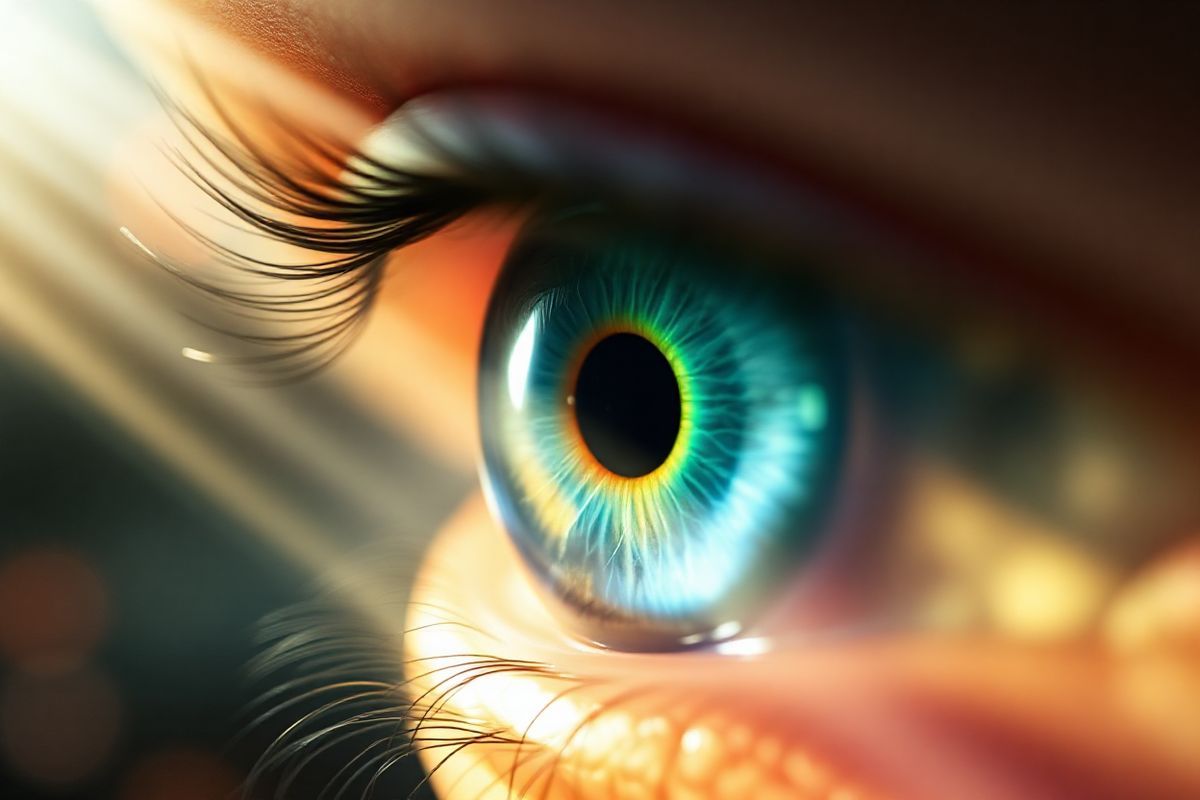Table of Contents
Understanding Macular Degeneration: Causes and Impact on Vision

Age-related macular degeneration (AMD) is the leading cause of severe vision loss in individuals aged over 50, with the Centers for Disease Control and Prevention estimating that 1.8 million Americans suffer from this debilitating condition, and another 7.3 million are at significant risk (American Optometric Association, n.d.). AMD primarily affects the macula, the central part of the retina responsible for sharp vision, and is categorized into two forms: dry and wet. The dry form, which constitutes about 80% of cases, is characterized by the gradual breakdown of light-sensitive cells in the macula, leading to slow vision loss. Conversely, wet AMD is marked by the growth of abnormal blood vessels that leak fluid and blood, causing rapid and severe vision loss.
The onset of AMD is influenced by several risk factors, including genetics, age, smoking, diet, and exposure to ultraviolet light. Symptoms often include blurred vision, distortion in the appearance of straight lines, and dark spots in central vision, which can severely impact daily activities such as reading, driving, and recognizing faces (National eye Institute, n.d.). The lack of effective treatments for dry AMD has spurred interest in novel approaches such as gene therapy, which holds promise in addressing the underlying biological mechanisms of the disease.
The Promise of Gene Therapy in Treating Ocular Diseases

Gene therapy is a cutting-edge technique that aims to correct or replace defective genes responsible for disease development. It has gained traction as a promising treatment modality for various ocular diseases, including AMD. The potential for gene therapy lies in its ability to target specific genes involved in the pathogenesis of AMD, thereby offering a more precise treatment approach than traditional therapies.
Currently, several gene therapy strategies are being explored in clinical trials. These strategies include gene addition, gene correction, gene silencing, and reprogramming. Each of these techniques has distinct mechanisms aimed at either enhancing the function of existing genes or replacing defective ones. For instance, gene addition involves inserting a healthy gene into a patient’s cells to restore normal function, whereas gene silencing aims to inhibit the expression of disease-causing genes (U.S. Food and Drug Administration, n.d.).
As of now, there are more than 1000 clinical trials listed on ClinicalTrials.gov investigating various gene therapy approaches for a wide range of diseases, including AMD. This reflects a growing recognition of the role gene therapy could play in ocular health and the treatment of degenerative conditions like AMD.
Mechanisms of Gene Therapy: How It Works to Combat Macular Degeneration
Gene therapy targets the molecular and genetic basis of AMD through several innovative mechanisms:
-
Gene Addition: This method involves delivering a copy of a healthy gene into retinal cells using viral vectors, such as adeno-associated viruses (AAVs). This approach aims to compensate for the loss of function caused by defective genes.
-
Gene Correction: Utilizing technologies like CRISPR/Cas9, defective genes can be edited to correct mutations at specific sites within the genome. This precise targeting has the potential to restore normal gene function.
-
Gene Silencing: In conditions where excessive protein production contributes to AMD, such as the overproduction of vascular endothelial growth factor (VEGF) in wet AMD, gene silencing techniques can reduce the expression of these proteins, potentially slowing disease progression.
-
Reprogramming: This strategy involves modifying the characteristics of certain types of cells to promote healthier function and potentially regenerate damaged retinal tissue.
-
Cell Elimination: In cases of malignant transformation or abnormal cell proliferation seen in certain forms of AMD, therapies can be designed to target and eliminate these dysfunctional cells.
In AMD, particularly wet AMD, the focus has been on targeting the VEGFA-VEGFAR2 signaling pathway, which is crucial for the growth of abnormal blood vessels. By disrupting this pathway through gene therapy, it may be possible to prevent or reverse the degenerative processes associated with wet AMD.
Current Advances in Gene Therapy Research for Macular Degeneration
Recent studies have demonstrated significant advancements in gene therapy for AMD. For example, a recent investigation explored the use of LDE-CjCas9, a modified Cas9 protein, for enhanced gene editing efficiency in retinal cells. This approach showed promise in delivering therapeutic genes directly to the eye, improving the precision and effectiveness of treatment (Chen et al., 2024).
Furthermore, research has indicated that microRNA-124 (miR-124) plays a crucial role in regulating inflammation and cell survival in the retina. Studies have shown that increasing miR-124 levels can decrease the expression of pro-inflammatory factors like CCL2, which is associated with photoreceptor cell death. This suggests that miR-124 mimics may serve as a potential therapeutic strategy for reducing inflammation in AMD patients (Chu-Tan et al., 2018).
The Age-Related Eye Disease Study (AREDS) has also highlighted the importance of antioxidants, such as lutein and zeaxanthin, in managing AMD. These compounds are thought to protect the retina from oxidative stress, which is a significant contributor to AMD progression. The combination of gene therapy with nutritional supplementation may provide a synergistic effect, enhancing the overall outcome for patients (American Optometric Association, n.d.).
Future Perspectives: What Lies Ahead for Gene Therapy and Eye Health
Looking forward, the potential for gene therapy in the treatment of AMD appears promising. With ongoing clinical trials and research focused on optimizing gene delivery methods, enhancing the efficacy of gene editing tools, and understanding the molecular mechanisms underlying AMD, we may soon see significant advancements in treatment options.
-
Personalized Medicine: As our understanding of genetic variations in AMD patients grows, personalized gene therapy approaches can be developed to target specific mutations in individual patients, ensuring more effective treatment.
-
Combination Therapies: The integration of gene therapy with existing treatments, such as anti-VEGF injections and nutritional supplementation, could enhance therapeutic outcomes and provide a multifaceted approach to managing AMD.
-
Technological Innovations: Advances in vectors for gene delivery, such as the development of smaller and more efficient viral vectors, will facilitate broader applications of gene therapy in ocular diseases.
-
Regulatory Approvals: As more gene therapies receive regulatory approval, accessibility for patients will improve, leading to a broader adoption of these innovative treatments.
-
Long-Term Studies: Ongoing and future studies will be crucial to assess the long-term safety and efficacy of gene therapies in AMD patients, providing data necessary for clinical practice.
In summary, gene therapy holds incredible potential for reversing or significantly slowing the progression of age-related macular degeneration. Continued research in this field will be vital in bringing these therapies to clinical practice and improving the quality of life for those affected by this debilitating condition.
FAQs
What is age-related macular degeneration (AMD)?
AMD is a progressive eye disease that affects the macula, leading to loss of central vision. It is the leading cause of vision loss in people over 50.
What are the types of AMD?
There are two main types of AMD: dry AMD, which is more common and progresses slowly, and wet AMD, which occurs when abnormal blood vessels grow under the retina and can lead to rapid vision loss.
How can gene therapy help with AMD?
Gene therapy can potentially correct or replace defective genes linked to AMD, reduce inflammation, and improve retinal cell survival, thus slowing disease progression or restoring vision.
What are some current gene therapy approaches for AMD?
Current approaches include gene addition, gene correction using CRISPR technology, and the use of microRNA mimics to regulate inflammatory processes in the retina.
What are the risks of gene therapy?
Risks may include immune reactions, targeting the wrong cells, or unintended genetic changes that could lead to complications such as cancer.
References
- American Optometric Association. (n.d.). Age-Related Macular Degeneration. Retrieved from https://www.aoa.org/healthy-eyes/eye-and-vision-conditions/macular-degeneration
- Chen, L., et al. (2024). A route to engineer a genome editor for gene therapy. Molecular Therapy - Nucleic Acids, 28, 102394. https://doi.org/10.1016/j.omtn.2024.102394
- Chu-Tan, J. A., et al. (2018). MicroRNA-124 Dysregulation Is Associated With Retinal Inflammation and Photoreceptor Death in the Degenerating Retina. Investigative Ophthalmology & Visual Science, 59(6), 2528-2553
- National Eye Institute. (n.d.). Age-related macular degeneration. Retrieved from https://medlineplus.gov/maculardegeneration.html
- U.S. Food and Drug Administration. (n.d.). What is Gene Therapy? Retrieved from https://www.fda.gov/vaccines-blood-biologics/cellular-gene-therapy-products/what-gene-therapy










